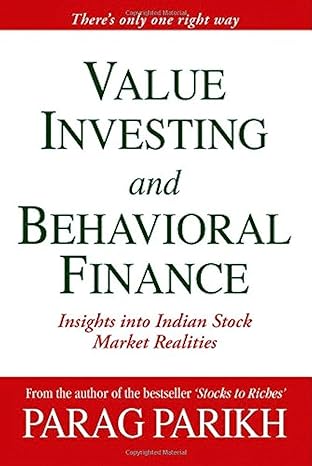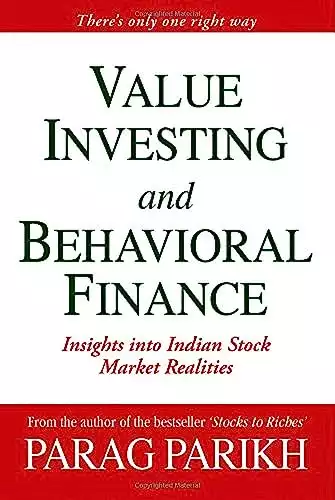Overview : Value Investing and Behavioral Finance
- Book Title: Value Investing and Behavioral Finance
- Author: Parag Parikh
- Publication Date: January 2009
- price: $23.00
- Pages: 252
Overview of the Book
The author of Value Investing and Behavioral Finance is a renowned expert in financial markets, blending decades of experience in investment strategies with a deep understanding of psychological principles influencing decision-making. The book uniquely combines timeless investing wisdom with insights into human behavior.
Introduction
In the ever-evolving world of finance and investing, understanding the interplay between rational analysis and human psychology is crucial. Parag Parikh's "Value Investing and Behavioral Finance: Insights into the Psychology of Investing" offers a comprehensive exploration of this relationship, providing readers with a powerful framework for making informed investment decisions.
Book Summary
Parikh's work masterfully combines two fundamental concepts in modern finance: value investing and behavioral finance. The book delves deep into the principles of value investing, popularized by legends like Benjamin Graham and Warren Buffett, while also examining the psychological factors that influence investor behavior.
Key Themes:
- The fundamentals of value investing
- Cognitive biases in financial decision-making
- The intersection of value investing and behavioral finance
- Practical strategies for applying these concepts
Analysis of Themes
Value Investing: The Foundation of Smart Investing
Parikh provides an in-depth explanation of value investing, emphasizing the importance of intrinsic value, margin of safety, and long-term perspective. He argues that successful value investing requires a disciplined approach, thorough research, and analysis to identify stocks trading below their true worth.
"The most important quality for an investor is temperament, not intellect." - Warren Buffett
This quote, highlighted by Parikh, underscores the importance of emotional discipline in value investing, a theme that resonates throughout the book.
Behavioral Finance: Understanding the Human Element
The book offers a comprehensive overview of behavioral finance, drawing on insights from psychology and economics. Parikh explores common cognitive biases such as overconfidence, anchoring, and herd behavior, explaining how these can lead to irrational investment decisions.
The Synergy of Value Investing and Behavioral Finance
One of the book's strengths is how it seamlessly integrates value investing principles with behavioral finance insights. Parikh argues that understanding the psychological aspects of investing is crucial for value investors aiming to capitalize on market inefficiencies and mispricings.
Writing Style
Parikh's writing style is clear, concise, and accessible to both novice and experienced investors. He uses relatable examples and case studies to illustrate complex concepts, making the book engaging and easy to follow.
Strengths and Weaknesses
Strengths:
- Comprehensive coverage of both value investing and behavioral finance
- Practical strategies and actionable insights
- Well-researched with numerous case studies and historical data
- Balanced approach to investing, considering both rational analysis and psychological factors
Weaknesses:
- Some readers may find certain sections too technical
- Limited discussion on emerging investment trends like cryptocurrencies
Comparison to Other Works
While books like Benjamin Graham's "The Intelligent Investor" focus primarily on value investing, and works like Daniel Kahneman's "Thinking, Fast and Slow" delve into behavioral economics, Parikh's book stands out for its successful integration of both disciplines. It offers a more holistic approach to investing compared to many other finance books.
Highlights from Value Investing and Behavioral Finance
- Value investing principles: Emphasizes investing in undervalued stocks with strong fundamentals.
- Behavioral finance: Explores how psychological factors affect investment decisions.
- Investor biases: Discusses common biases like overconfidence and loss aversion that impact market behavior.
- Market inefficiencies: Shows how irrational behavior creates opportunities for value investors.
- Long-term strategy: Advocates for patience and disciplined investing to counteract short-term market fluctuations.
- Risk management: Stresses the importance of understanding risk and using a margin of safety in investing.
Conclusion
"Value Investing and Behavioral Finance" is an invaluable resource for anyone looking to enhance their investment strategy. By merging timeless value investing principles with modern behavioral finance insights, Parikh provides a comprehensive framework for navigating the complexities of financial markets. The book's emphasis on discipline, patience, and self-awareness makes it particularly relevant in today's volatile market conditions. Whether you're a seasoned investor or just starting your financial journey, this book offers profound insights that can help you make more informed and rational investment decisions.
Who Should Read This Book?
- Individual investors looking to improve their investment strategy
- Finance professionals seeking a deeper understanding of market psychology
- Students of finance and economics
- Anyone interested in the intersection of psychology and financial markets





